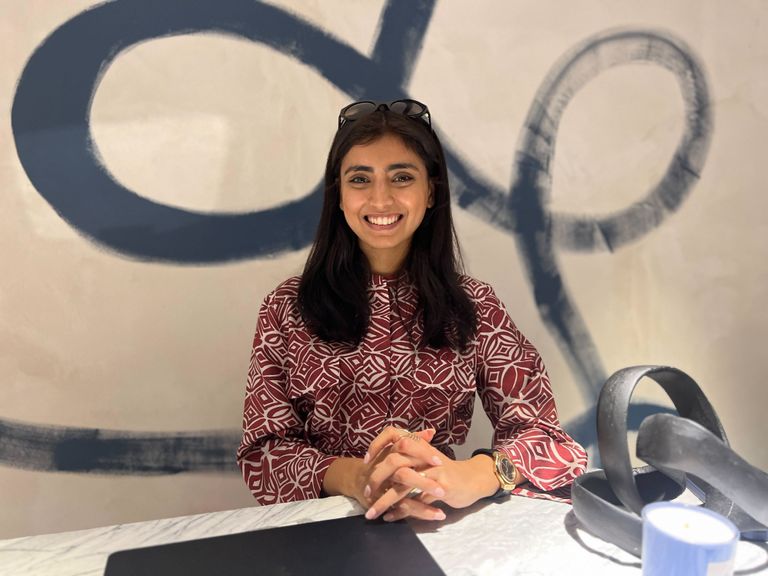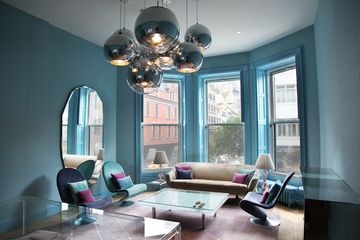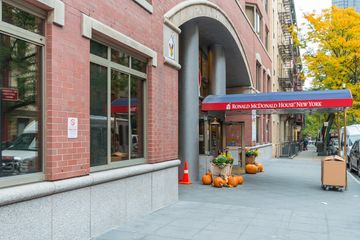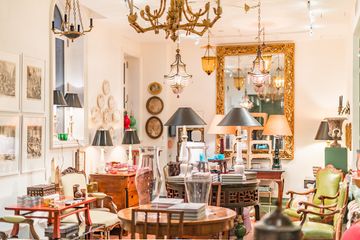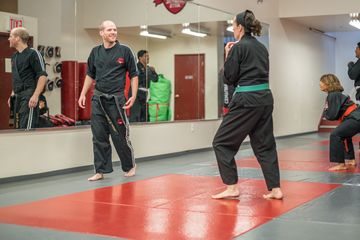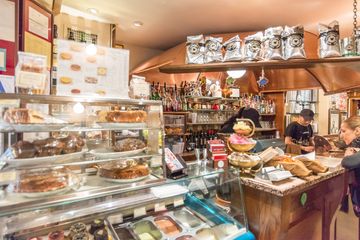Whenever I step inside Via Quadronno, I feel like I have been lifted out of Manhattan and gently dropped onto a pedestrian street in Italy. The walls are lined with wines and jars of honey, jam, and olive oil. On the day when I descended into the warm, rustic dining area, there was the smell of cappuccino wafting through the air that attracted my senses. It was the owner, Paolo Della Puppa, however, as authentically Italian as his restaurant, who captured my heart. Paolo spoke to me about the history of Via Quadronno, which is intertwined with his own story as well as the social history of the world. He began his career publishing music through his own company, Anyway Music. He went on to sell Anyway to Warner Brothers in 1992. In 1983, Paolo moved to New York while continuing to run the business, but when the conversion rate jumped to 2000 lira for every dollar, he realized he needed to find a new job. Friends encouraged Paolo to speak with Hans Pauli, owner of the recently opened Sant Ambroeus on Madison Avenue. At this point in his story, Paolo took a moment to explain Hans Pauli's background. I had previously heard a bit of this story, as I had visited Sant Ambroeus on West 4th Street when I first began walking the side streets. Nevertheless, it was fascinating to hear Paolo share what he knew about Hans. He told me that Hans had bought Sant Ambroeus, which originally opened in the fashion district in Milan in 1936 and was regarded as one of the nicest cafes in the city. Apparently, when Hans Pauli became the highest bidder to purchase this Italian icon - all in cash - he created quite a stir. Enthusiastically, Paolo went on to tell me that the reason why Hans had the money was because of his success with Bar Quadronno, the hottest paninoteca in Milan. Paolo, who had owned a discoteca from 1972-1974, explained that paninotecas had become popular because of the social revolution of the 60s. As discotecas became the default entertainment for young people - who now could go out and dance without any dress code or elaborate partner rituals - Italians were looking for grab-and-go food that would fit their lifestyle. Bar Quadronno opened in the late 60s and turned the original Panini, which was traditionally just ham and cheese, into a new food sensation with the help of a man named Giuseppe Tusi. Giuseppe Tusi turned a two-ingredient sandwich into a seven-ingredient masterpiece, using tomatoes, mozzarella, prosciutto, boar’s ham, and countless other traditional Italian foods. Returning to his personal story, Paolo went on to tell me that when he inquired about a position at Sant Ambroeus, Hans simply asked him if he could make a good cup of cappuccino. Paolo replied, “Do I need to show a diploma? ” Paolo laughed and declared to me, "any true Italian knows how to make a cappuccino. " He then added that Martha Stewart has taped a show in Via Quadronno about how to prepare the perfect cup. Paolo worked at Sant Ambroeus for years before opening Via Quadronno with Hans on 9/9/1999 - “My partner is a little superstitious, ” he explained with a grin. Taking the story full circle, he ended by telling me that the two men then brought in Giuseppe to train the Panini chefs, allowing Via Quadronno to churn out the exact paninis that made Bar Quadronno an instant hit in Milan over fifty years ago. Ultimately, Paolo began to fly solo, turning his restaurant into an Upper East Side sensation. He continued to join in other successful ventures in New York, as well as opening a second location of Via Quadronno. Paolo proudly said that even after so many years, his first restaurant is “still very much loved” among its neighbors. He even mentioned numerous actors and actresses who are known to stop in for the tiramisu and other classic dishes. Despite the flock of familiar faces to this Upper East Side institution, Paolo assured me that he treats all of his customers the same - from tourists to celebrities. “Everyone is equal - everyone waits for a table. " He then went on to say, “We are not pretentious, in fact, we receive compliments on how friendly we are. ”Of the many stories that Paolo shared with me, the one that involved a successful businessman was my favorite. Apparently, several years ago, this gentleman requested that Paolo open a bit earlier in the morning to accommodate his schedule. If Paolo complied, and began his day a half an hour sooner, the man would then invest the hundreds of thousands of dollars needed to open a Miami location of Via Quadronno. Check, check. Although the Florida restaurant has since closed, the Manhattan restaurant continues to open its doors every weekday morning at 8: 00am. Paolo will never forget this kind man who did not want shares or a percentage in his business, he just wanted breakfast. Paolo said that he returns to Italy multiple times each year, either to visit family or to attend the restaurant show, Host, in Milan. He then grinned and admitted that he loves New York, and has no desire to move away. As he so brilliantly summed it up, “New York is Tokyo, Paris, Madrid, Milano, Hong Kong, and Shanghai in one. And all the best parts of each! ”
